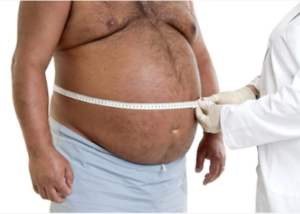If a woman weighs more than most NFL linemen, could she ever be strong, fit and healthy?
A weight of 300 pounds is a lot even for a six foot man.
The question of whether or not a person – male or female – could possibly be strong, fit and healthy at 300 pounds is compound.
That’s because a morbidly obese individual can actually be quite strong – as in the sports of powerlifting and Olympic-style weightlifting.
There are images on Instagram of women, who appear to be around 300, performing powerlifting moves.
The three moves in powerlifting are the bench press, back squat and deadlift.
They can also be seen on YouTube. It’s no secret in the powerlifting world that “mass moves mass.”
Olympic-style weightlifting is another power based sport in which the heaviest of these athletes also lift the heaviest amounts of weight over their heads.
Thus, “Strong at any size” rings very true – with a lot of dedicated training.
“However, ‘Strong at any size does not equate to being healthy at any size,” says Supriya Rao, MD, director of Medical Weight Loss at Lowell General Hospital and managing director of Integrated Gastroenterology Consultants.
Being able to lift heavy barbells doesn’t equate to a high degree of cardiovascular fitness, and especially a high degree of health in the body such as low levels of systemic inflammation.
Another point to consider is that on a population level, VERY FEW 300 pound people do any powerlifting or Olympic-style weightlifting.
In fact, population-wise, only a very small number of people of any size are powerlifting or Olympic-style weightlifting enthusiasts – despite the number of powerlifting gyms and people seen at standard gyms performing these strength moves.
When I was a personal trainer, my very large clients – who were new to strength training – were started with barbells in the same load range as were my smaller clients.
“Powerlifters with severe obesity who can lift very heavy barbells may have impressive strength, but the reality remains that their level of obesity is still detrimental to their health,” says Dr. Rao.
“Even though physical activity has numerous benefits and should be encouraged for people of all sizes, it cannot undo the damage caused by obesity.
“Having obesity increases the risk for chronic diseases: things like heart disease, high blood pressure, type 2 diabetes, stroke, etc.”
In a nutshell, obesity is an independent risk factor – and causative agent – for many serious conditions.
“The biggest musculoskeletal risk of being morbidly obese is increased risk for early development of knee arthritis,” says Dr. Dave Candy, a board certified specialist in orthopedic physical therapy.
“Relative to someone with a normal BMI (20.0 – 24.9), people with a BMI of 36 or greater have a 13.6 times greater risk of developing knee osteoarthritis.
“Furthermore, even one in four American football players at the NFL combine has knee arthritis, despite being young and healthy, but often overweight.”
Fitness at 300 Pounds?

If you peruse Instagram enough, you’ll find accounts by very large individuals showing them out on hikes or even training for a triathlon or 10K run.
But does a slowly-done hike, or the completion of a 10K route at a very slow trot, always mean that a very big person is physically fit?
Well certainly, they are far fitter than they’d ever be if they lived a sedentary life.
However, their ability to attain a much greater degree of fitness is hampered by the excess weight.
There’s also a greater risk of knee wear-and-tear from impact activities.
“Physical fitness is much more than the ability to cross a finish line; it involves strong muscles, good endurance and agility, and flexibility,” says Dr. Rao.
“Furthermore, even if the person can complete these activities, it does not necessarily mean they are healthy.
“Having obesity puts a person at risk of developing severe health problems like diabetes and heart disease.”
If you believe a morbidly obese person is healthy on the inside, through-and-through, just because they completed a slow trot up a mile-long, inclined trail, look at it this way:
When my aunt, a smoker, was in her 80s, she got to the top of the Mother Cabrini Shrine, which is 373 steps.
According to the premise that “getting to the finish line” means good fitness and health, my old, smoking aunt was fit and healthy! No. No.
But – she sure as hell was determined – and patient, taking her time. Determination and patience don’t = healthy and fit.
More power to the 300 pound woman who crosses the finish line of the 5K charity walk, but she’s still at very high risk for future disease.
“Additionally, obesity is linked to lower back pain as well,” says Dr. Candy.
“Most studies [for back pain] that I’m aware of have been performed on male populations, although I can speak from clinical experience that the trend appears to hold up in women as well.
“Simply put, no matter how fit you are, more body mass puts increased stress on your joints.
“You can’t fight the laws of gravity.
“That’s not to say that it’s not okay for athletes like powerlifters and Olympic weightlifters to be ‘strong at any size.’
“However, it does carry with it consequences that many young athletes don’t take into consideration until after the damage has already been done.”
Next time you see a video or image of a morbidly obese person lifting a very impressive amount of weight, guess their age based on their face.
Chances are extremely high your guess will be in the 20s. The next likely bracket will be 30s.
The chances of your guess being in the 40s are very nil.
Nevertheless, there are very heavy, competitive powerlifters in their 40s, even 50s, who’ve been training for years.
Most are men who are taller than the average height for a female.
There’s a big difference between a woman of 5’4 who weighs 300, and a man of 6’1 who weighs 300.
Though both are morbidly obese, the man’s BMI comes in at 39, while the woman’s is a whopping 51.
Both measurements are medically very undesirable, but the higher the BMI over 30, the worse off, statistically, a person will be.
The woman here has significantly more excess body fat than does the man.
The “strong at any size” ideology using competitive athletes as examples should not be used as a yardstick for the AVERAGE woman or man whose weight hovers around 300.
 Dr. Rao is board certified in internal medicine, gastroenterology, obesity medicine and lifestyle medicine. She is managing director of Integrated Gastroenterology Consultants, and director of Medical Weight Loss at Lowell General Hospital. She also runs the motility program, which focuses on disorders of the esophagus, irritable bowel syndrome and anorectal disorders.
Dr. Rao is board certified in internal medicine, gastroenterology, obesity medicine and lifestyle medicine. She is managing director of Integrated Gastroenterology Consultants, and director of Medical Weight Loss at Lowell General Hospital. She also runs the motility program, which focuses on disorders of the esophagus, irritable bowel syndrome and anorectal disorders.
 Dr. Dave Candy, PT, DPT, is a specialist in orthopedic physical therapy and owner of More 4 Life. He’s the author of Chronic Pain: You’re Not Just Getting Older, You’re Not Crazy, And It’s Not All In Your Head, available on Amazon.
Dr. Dave Candy, PT, DPT, is a specialist in orthopedic physical therapy and owner of More 4 Life. He’s the author of Chronic Pain: You’re Not Just Getting Older, You’re Not Crazy, And It’s Not All In Your Head, available on Amazon.
 Lorra Garrick is a former personal trainer certified through the American Council on Exercise. At Bally Total Fitness she trained women and men of all ages for fat loss, muscle building, fitness and improved health.
Lorra Garrick is a former personal trainer certified through the American Council on Exercise. At Bally Total Fitness she trained women and men of all ages for fat loss, muscle building, fitness and improved health.
.


























